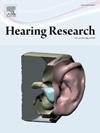A mutation in Tmem135 causes progressive sensorineural hearing loss
IF 2.5
2区 医学
Q1 AUDIOLOGY & SPEECH-LANGUAGE PATHOLOGY
引用次数: 0
Abstract
Transmembrane protein 135 (TMEM135) is a highly conserved 52 kDa protein with five predicted transmembrane domains that colocalizes with mitochondria and peroxisomes. Previous studies have shown that TMEM135 is involved in mitochondrial dynamics, thermogenesis, and lipid metabolism across multiple tissues and species; however, its role in the inner ear and auditory system remains unknown. We investigated the function of TMEM135 in hearing using wild-type (WT) and Tmem135FUN025/FUN025 (FUN025) mutant mice on a CBA/CaJ background, a normal-hearing mouse strain. Although FUN025 mice displayed normal auditory brainstem response (ABR) thresholds at 1 month, we observed significantly elevated ABR thresholds at 8, 16, and 64 kHz by 3 months, which progressed to profound hearing loss by 12 months. Consistent with our auditory testing results, 13-month-old FUN025 mice exhibited a severe loss of outer hair cells and more modest changes in inner hair cell survival, spiral ganglion neuron density, and stria vascularis integrity in the cochlea. Our results using BaseScope RNA in situ hybridization indicate that TMEM135 is expressed in the inner hair cells, outer hair cells, supporting cells, and stria vascularis. Using Volocity software and Costes colocalization analysis, we found that TMEM135 closely colocalizes with mitochondria in hair cells. Together, these results demonstrate that the FUN025 mutation in Tmem135 causes progressive sensorineural hearing loss, and suggest that TMEM135 is crucial for maintaining key cochlear cell types and normal sensory function in the aging cochlea.
Tmem135基因突变导致进行性感音神经性听力损失
跨膜蛋白135 (TMEM135)是一种高度保守的52 kDa蛋白,具有5个预测的跨膜结构域,与线粒体和过氧化物酶体共定位。先前的研究表明,TMEM135参与多种组织和物种的线粒体动力学、产热和脂质代谢;然而,它在内耳和听觉系统中的作用尚不清楚。我们使用正常听力小鼠品系CBA/CaJ背景下的野生型(WT)和Tmem135FUN025/FUN025 (FUN025)突变小鼠来研究TMEM135在听力中的功能。尽管FUN025小鼠在1个月时表现出正常的听觉脑干反应(ABR)阈值,但在3个月时,我们观察到8、16和64 kHz的ABR阈值显著升高,并在12个月时发展为深度听力损失。与我们的听觉测试结果一致,13个月大的FUN025小鼠表现出严重的外毛细胞损失,内毛细胞存活、螺旋神经节神经元密度和耳蜗血管纹完整性的变化更为温和。我们使用BaseScope RNA原位杂交的结果表明,TMEM135在内毛细胞、外毛细胞、支持细胞和血管纹中表达。利用Volocity软件和Costes共定位分析,我们发现TMEM135与毛细胞中的线粒体紧密共定位。总之,这些结果表明,Tmem135中的FUN025突变导致进行性感觉神经性听力损失,并表明Tmem135对于维持老化耳蜗中关键耳蜗细胞类型和正常感觉功能至关重要。
本文章由计算机程序翻译,如有差异,请以英文原文为准。
求助全文
约1分钟内获得全文
求助全文
来源期刊

Hearing Research
医学-耳鼻喉科学
CiteScore
5.30
自引率
14.30%
发文量
163
审稿时长
75 days
期刊介绍:
The aim of the journal is to provide a forum for papers concerned with basic peripheral and central auditory mechanisms. Emphasis is on experimental and clinical studies, but theoretical and methodological papers will also be considered. The journal publishes original research papers, review and mini- review articles, rapid communications, method/protocol and perspective articles.
Papers submitted should deal with auditory anatomy, physiology, psychophysics, imaging, modeling and behavioural studies in animals and humans, as well as hearing aids and cochlear implants. Papers dealing with the vestibular system are also considered for publication. Papers on comparative aspects of hearing and on effects of drugs and environmental contaminants on hearing function will also be considered. Clinical papers will be accepted when they contribute to the understanding of normal and pathological hearing functions.
 求助内容:
求助内容: 应助结果提醒方式:
应助结果提醒方式:


